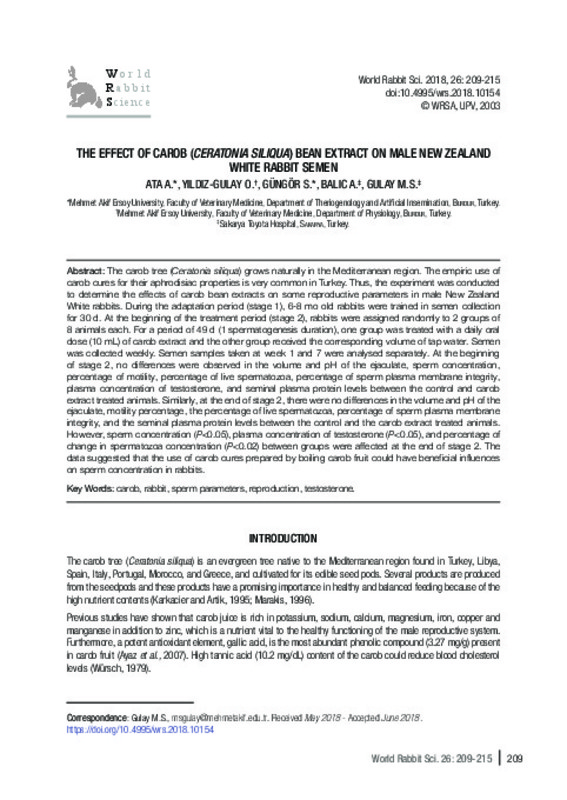Abd El-Ghany M.A. 2007. The relation of antioxidants and sodium nitrite on the oxidation reduction system and reproductive ability of male rats. Egypt J. Nutr., 2: 33-64.
Agnes V.F., Akbarsha M.A. 2003. Spermatotoxic effect of aflatoxin B1 in the albino Mouse. Food. Chem. Tox., 41: 119-130. https://doi.org/10.1016/S0278-6915(02)00171-0
Amico F.P., Source E.G. 1997. Medical plants and phytotheraphy in Mussomeli area (Caltenisseta, Scily, Italy). Fitoterapia, 68: 143-159.
[+]
Abd El-Ghany M.A. 2007. The relation of antioxidants and sodium nitrite on the oxidation reduction system and reproductive ability of male rats. Egypt J. Nutr., 2: 33-64.
Agnes V.F., Akbarsha M.A. 2003. Spermatotoxic effect of aflatoxin B1 in the albino Mouse. Food. Chem. Tox., 41: 119-130. https://doi.org/10.1016/S0278-6915(02)00171-0
Amico F.P., Source E.G. 1997. Medical plants and phytotheraphy in Mussomeli area (Caltenisseta, Scily, Italy). Fitoterapia, 68: 143-159.
Ata A., Hatipoglu F.S., Yildiz-Gulay O., Gulay M.S. 2007. Protective role of ascorbic acid on subacute sperm toxicity in male New Zealand White Rabbits treated with endosulfan. Drug Chem. Toxicol., 30: 181-195. https://doi.org/10.1080/01480540701374896
Ayaz F.A., Torun H., Ayaz S., Correia P.J., Alaiz M., Sanz C., Gruz J., Strand M. 2007. Determination of chemical composition of Anatolian carob pod (Ceratonia siliqua L.), Sugars, amino and organic acids, minerals and phenolic compounds. J. Food Quality, 30: 1040-1055. https://doi.org/10.1111/j.1745-4557.2007.00176.x
Feng P., Li TL., Guan Z.X., Franklin R.B., Costello L.C. 2002. Direct effect of zinc on mitochondrial apoptogenesis in prostate cells. Prostate, 52: 311-318. https://doi.org/10.1002/pros.10128
Hala M.A.W. 2011. Protective effect of Nigella sativa, linseed and celery oil against testicular toxicity induced by sodium valproate in male rats. J. Am. Sci., 7: 687-693.
Inouce M., Suzuki R., Koide T., Sakaguchi N., Ogihera Y., Yabu Y. 1994. Antioxidant, gallic acid, induces apaptosis in HL- 60RG cells. Biochem. Res. Commun., 204: 898-904. https://doi.org/10.1006/bbrc.1994.2544
Karkacier M., Artik N. 1995. Determination of physical properties, chemical composition and extraction conditions of carob bean (Ceratonia siliqua L.). Gida, 20: 131-136.
Katsiya G.V., Todua T.N., Gorlushkin V.M., Chirkov A.M., Goncharov N.P. 1989. Effect of immobilization stress on the gonadotropic function of the hypophysis in male hamadryas baboons (Papio hamadryas). Biol. Medit., 107: 231-234.
Marakis S. 1996. Carob bean in food and feed: current status and future potentials: a critical appraisal. J. Food Sci. Technol., 33: 365-383.
Merzouki A., Ed-Derfoufi F., El Allau A., Molero-Mesas J. 1997. Wild medicinal plants used by local Bouhmed population (Morocco). Fitoterapia, 68: 444-460.
Rickard I.J., Holopainen J., Helama S., Helle S., Russell A.F., Lummaa V. 2010. Food availability at birth limited reproductive success in historical humans. Ecology, 91: 3515-3525. https://doi.org/10.1890/10-0019.1
Robbins W.A., Xun L., FitzGerald L.Z., Esguerra S., Henning S.M., Carpenter C.L. 2012. Walnuts Improve Semen Quality in Men Consuming a Western-Style Diet: Randomized Control Dietary Intervention Trial. Biol. Reprod., 87: 101-108. https://doi.org/10.1095/biolreprod.112.101634
Osaretin A.T., Gabriel A.A. 2008. Effect of zinc deficiency on memory, oxidative stress and blood chemistry in rats. Adv. Med. Dent. Sci., 2: 74-82.
Saracoglu A.I. 2011. Şifa Kitabı, 1st ed. Haygrup Publishers, Istanbul, Turkey.
Takeda A., Tamano H., Tochigi M. 2005. Zinc homeostasis in the hypocampus of zinc deficient young adult rats. J. Neurochem. Int., 46: 221-225. https://doi.org/10.1016/j.neuint.2004.10.003
Tokeshi I., Yoshimoto T., Muto N., Nakamura S., Ashizawa K., Nakada T., Tatemoto H. 2007. Antihyaluronidase action of ellagic acid effectively prevents polyspermy as a result of suppression of the acrosome reaction induced by sperm-zona interaction during in vitro fertilization of porcine oocytes. J. Reprod. Develop., 53: 755-764. https://doi.org/10.1262/jrd.18173
Turk G., Sonmez M., Aydin M., Yuce A., Gur S., Yuksel M., Aksu E.H., Aksoy H. 2008. Effects of pomegranate juice consumption on sperm quality, spermatogenic cell density, antioxidant activity and testosterone level in male rats. Clin. Nutr., 27: 289-296. https://doi.org/10.1016/j.clnu.2007.12.006
Würsch P. 1979. Influence of tannin-rich carob pod fiber on the cholesterol metabolism in the rat. J. Nutr., 109: 685-692. https://doi.org/10.1093/jn/109.4.685
Zago M.P., Oteiza P.I. 2001. The antioxidant properties of zinc: interactions with iron and antioxidants. Free Rad. Biol. Med., 31: 266-274. https://doi.org/10.1016/S0891-5849(01)00583-4
[-]








